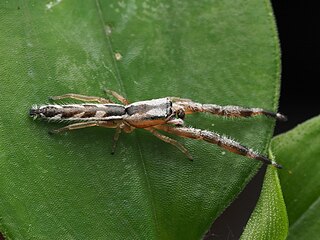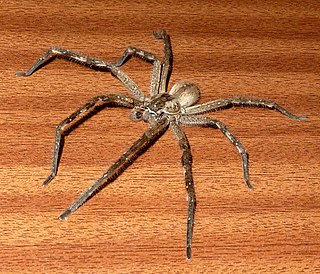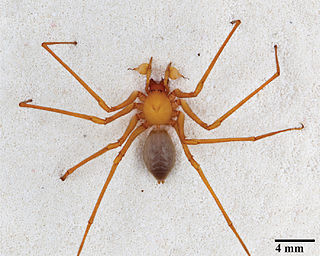
Actinopodidae is a family of mygalomorph spiders found in mainland Australia and South America usually in open forest. Species are most common in Queensland, Australia. It includes mouse spiders, whose bites, though rare, are considered medically significant and potentially dangerous.

Platycryptus undatus, also called the tan or familiar jumping spider, is a species of jumping spider.
Gambaquezonia is a genus of the spider family Salticidae with two species. It was first described in some detail by Barrion & Litsinger (1995) from the female holotype, the only known specimen at the time. Its general appearance was later redescribed by Murphy and Murphy (2000).

Marchena is a genus of jumping spiders only found in the United States. Its only described species, M. minuta, dwells on the barks of conifers along the west coast, especially California, Washington and Nevada.

Periegops is a genus of spiders with six eyes instead of the usual eight. It is the only genus in its family (Periegopidae) and has three described species. It was long considered to be a member of Sicariidae or Segestriidae until Raymond Forster elevated it to the family level in 1995.

Sphodros is a genus of North American purseweb spiders first described by Charles Athanase Walckenaer in 1835. It was considered a synonym of Atypus until 1980.

Sphodros rufipes, sometimes called the red legged purseweb spider, is a mygalomorph spider from the southern United States, though it has been photographed as far north as Indiana, Missouri, New Jersey, Minnesota, Tennessee, Delaware, Louisiana, and Tuckernuck Island in Massachusetts [West Virginia]. A recent sighting shows that these spiders can also be found in Canada. Recent sighting also in Kansas.
Notnops is a monotypic genus of South American araneomorph spiders in the family Caponiidae, containing the single species, Notnops calderoni. It was first described by Norman I. Platnick in 1994, and has only been found in Chile. They have an orange carapace with yellow legs. Males have a body length of about 2 millimetres (0.079 in) long, and females are slightly larger, with a body length up to 3 millimetres (0.12 in).

Myrmaplata plataleoides, also called the red weaver-ant mimicking jumper, is a jumping spider that mimics the Asian weaver ant in morphology and behaviour. This species is found in India, Sri Lanka, China and many parts of Southeast Asia.

Maevia inclemens or the dimorphic jumping spider is a relatively common and colorful jumping spider of North America. In the males there are two forms, a very rare phenomenon in zoology. These use different courting displays, and differ in appearance: the "tufted" morph has a black body and pedipalps ("palps"), three black tufts across its "head", and pale legs; and the "gray" morph has black and white stripes all over its body and legs, orange palps, and no tufts. However, each form accounts for 50% of the adult males, and they are equally successful in mating. A female of Maevia inclemens is 6.5 to 8.0 millimetres long, while males are 4.75 to 6.50 millimetres long.

Unicorn ("one horn", in Latin) is a genus of goblin spiders from South America, containing seven species that occur predominantly in high elevation, semi-desert regions of Bolivia, Chile, and Argentina. Individuals are relatively large for goblin spiders, measuring up to 3.0 mm (0.12 in) in body length. The genus name refers to a characteristic pointed projection between the eyes and jaws of males. In at least one species, broken-off tips of the male pedipalps have been found within the genitalia of females, postulated as a means of sperm competition. Unicorn possesses several traits that suggest it is a relatively "primitive" member of the Oonopidae, and is classified with other similar, soft-bodied goblin spiders in the subfamily Sulsulinae.

Marpissa pikei is a species of jumping spider that is found in the eastern United States, Texas, New Mexico, Arizona and Cuba.
Harpactea sadistica is a species of dysderine spider, found only in Israel. It was first described in 2008.

Zygoballus sexpunctatus is a species of jumping spider which occurs in the southeastern United States where it can be found in a variety of grassy habitats. Adult spiders measure between 3 and 4.5 mm in length. The cephalothorax and abdomen are bronze to black in color, with reddish brown or yellowish legs. The male has distinctive enlarged chelicerae and front femora. Like many jumping spiders, Z. sexpunctatus males exhibit ritualized courtship and agonistic behavior.

Rugathodes sexpunctatus is a minute species of spider in the family Theridiidae, the cobweb or tangle-web spiders. This family includes the medically important genus Latrodectus—the widow spiders. The species in the genus Rugathodes are too small to be dangerous to humans. Very little is known about most species in this genus.
Sphodros atlanticus is a species of spiders from the family Atypidae. It was described by Willis J. Gertsch and Norman I. Platnick in 1980. The species was described from specimens found in Georgia, North Carolina, Virginia and Illinois. It has also been found in Maryland and Alabama.

The common rain spider, formerly P. natalius, is a species of huntsman spider native to Southern Africa. It is the most common and widespread species in the genus Palystes. In South Africa its distribution ranges from KwaZulu-Natal province in the east, then westwards to the provinces of Mpumalanga, Limpopo, Gauteng and North West in the north, and Eastern Cape and Western Cape in the south. It has a body length of 15–36 mm and a leg span of up to 110mm. The species was first described by Ludwig Carl Christian Koch in 1875.

Trogloraptor is a genus of large spiders found in the caves of southwestern Oregon. It is the sole genus in the family Trogloraptoridae, and includes only one species, Trogloraptor marchingtoni. These spiders are predominantly yellow-brown in color with a maximum leg span of 3 in (7.6 cm). They are remarkable for having hook-like claws on the raptorial last segments of their legs.

Progradungula otwayensis, commonly known as the odd-clawed spider, is a species of cribellate spider endemic to the Great Otway National Park of Victoria, Australia. It is one of only two species in the gradungulid genus Progradungula.














